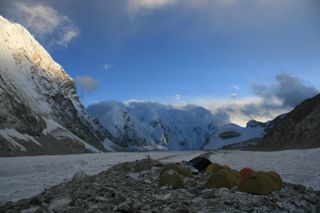Why Does This Glacier Near Everest Make Loud Booming Sounds at Night?

And the researchers figured out why: At night in the Himalayas, the temperature would drop sharply, by dozens of degrees. In a paper published Aug. 29 in the journal Geophysical Research Letters, the researchers showed that when temperatures dropped sharply at night, the booming, eerie noises were more intense. And it was concentrated in regions where wind had cleared snow and debris from the ice surface, exposing the glacier to the air.
"Local ice turns out to be very sensitive to this high rate of change," Evgeny Podolskiy, a glaciologist at the Arctic Research Center in Hokkaido University, in Japan, and lead author of the paper, said in a statement. [Time-Lapse Images of Retreating Glaciers]
During the day, the ice is quiet and still. But after sunset, the scientists wrote, temperature changes likely cause exposed ice to shrink, fracturing it as individual regions warp away from one another. The cracks aren't necessarily visible from the surface, but the noises they make were loud enough to keep the research team up at night, according to the statement.
To study the effect in precise, scientific terms, the researchers distributed seismic sensors across the ice, the same technology used to study earthquakes. The sensors would make long-term recordings of vibrations in the ice, which the researchers could compare to temperature and wind data. That helped them make the firm connection between the temperature swings and the booming.
This research is important, the researchers said, because a great deal of glaciology happens at the edges of glaciers, which, as Live Science has reported, are crumbling and retreating and dumping water into oceans all over the world, and are where most of the action is. Understanding what happens inside glaciers as temperatures move will help researchers better understand their behavior.
Originally published on Live Science.
Sign up for the Live Science daily newsletter now
Get the world’s most fascinating discoveries delivered straight to your inbox.

Most Popular

